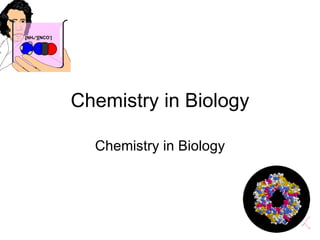Report
Share

More Related Content
What's hot
What's hot (20)
Carbonyl Compounds (Aldehydes & Ketones) Full Explanation

Carbonyl Compounds (Aldehydes & Ketones) Full Explanation
Biology - Chp 2 - The Chemistry Of Life - PowerPoint

Biology - Chp 2 - The Chemistry Of Life - PowerPoint
Viewers also liked
Viewers also liked (20)
Similar to Biochemistry review presentation
Similar to Biochemistry review presentation (20)
important slide related to physiology as well different cell structure.pptx

important slide related to physiology as well different cell structure.pptx
Biochemistry review presentation
- 1. Chemistry in Biology Chemistry in Biology
- 4. Isotopes, Radioactive Isotopes Atoms of the same element that have different numbers of neutrons are called isotopes. If an atom is unstable , the nucleus can decay and give off radiation – these are called radioactive isotopes. Carbon-14 is a radioactive isotope that is found in all living things. Scientists can determine how old an object is by determining how much Carbon 14 is in the object.